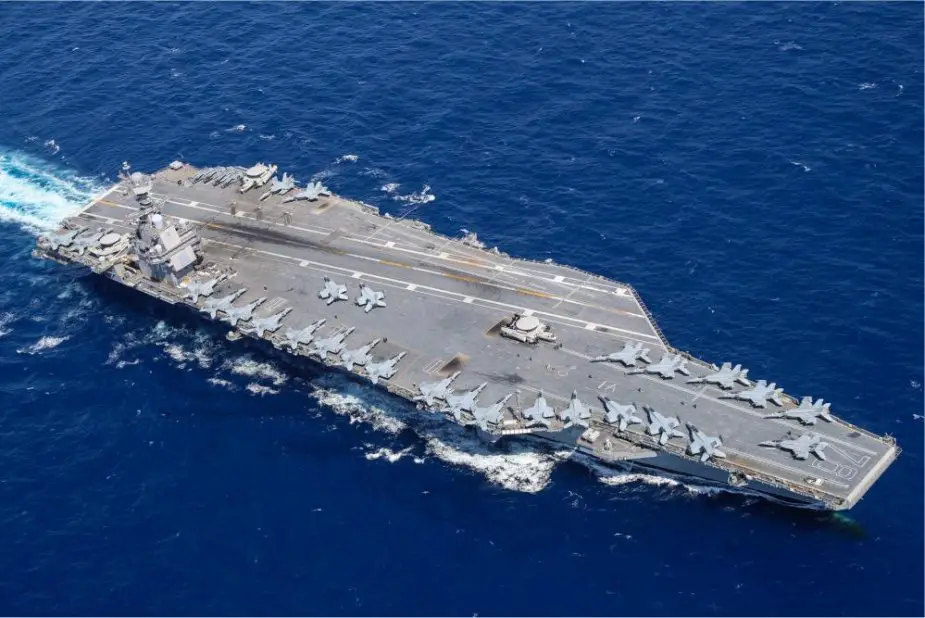Breaking news
US Navy's aircraft carrier Gerald R. Ford to be deployed for the first time.
According to information published by the US DoD on September 29, 2022, the Navy's newest and most advanced aircraft carrier USS Gerald R. Ford (CVN 78) will deploy and operate alongside a coalition of allied forces together in the Atlantic area of operations.
Follow Navy Recognition on Google News at this link
 Gerald R. Ford-class aircraft carrier USS Gerald R. Ford. (Picture source: US DoD)
Gerald R. Ford-class aircraft carrier USS Gerald R. Ford. (Picture source: US DoD)
Ford is the flagship of the Gerald R. Ford Carrier Strike Group (GRFCSG) and their first operational deployment will include air, maritime, and ground assets from NATO Allies and partner nations. The strike group will set sail from Norfolk, Virginia, and will operate in the Atlantic Ocean.
Innovation and interoperability are the key focal points of the GRFCSG’s deployment, allowing allied and partner nations to strengthen the collective defense of the Atlantic as well as to mature integration for future operations.
Along with Allies and partners, the GRFCSG will focus training on air defense, anti-subsurface warfare, distributed maritime operations, mine countermeasures, and amphibious operations.
The deployment involves approximately 9,000 personnel from nine nations, 20 ships, and 60 aircraft. The nine participating nations are: U.S, Canada, Denmark, Finland, France, Germany, the Netherlands, Spain, and Sweden.
The U.S. commands and units participating in the Gerald R. Ford Carrier Strike Group (GRFCSG) deployment include Carrier Strike Group (CSG) 12, Carrier Air Wing (CVW) 8, Destroyer Squadron (DESRON) 2, USS Normandy (CG 60), USS Ramage (DDG 61), USS McFaul (DDG 74), USS Thomas Hudner (DDG 116), USNS Joshua Humpreys (T-AO 188), USNS Robert E. Peary (T-AKE 5), and USCGC Hamilton (WHEC 715).
About the USS Gerald R. Ford
USS Gerald R. Ford (CVN-78) is the lead ship of her class of United States Navy aircraft carriers. She was delivered to the Navy on 31 May 2017 and formally commissioned by President Donald Trump on 22 July 2017.
The new vessels have a hull similar to the Nimitz-class, but introduce technologies since developed with the CVN(X)/CVN-21 program, such as the Electromagnetic Aircraft Launch System (EMALS), as well as other design features intended to improve efficiency and reduce operating costs, including sailing with smaller crews.
The Electromagnetic Aircraft Launch System (EMALS) launches aircraft by means of a catapult employing a linear induction motor rather than the steam piston used on the Nimitz class.
The EMALS accelerates aircraft more smoothly, putting less stress on their airframes. The EMALS also weighs less, is expected to cost less and require less maintenance, and can launch both heavier and lighter aircraft than a steam piston-driven system. It also reduces the carrier's requirement of fresh water, thus reducing the demand for energy-intensive desalination.
The Gerald R. Ford class has a length of 333 m, a width of 77 m, and a displacement of 100,000 tons and is equipped with AN/SPY-3 and AN/SPY-4 active electronically scanned array multi-function radar.
The armament of the USS Gerald R. Ford-class consists of two RIM-162 ESSM launchers, two RIM-116 RAM, three Phalanx CIWS, and four M2 .50 Cal. (12.7 mm) machine guns.



























